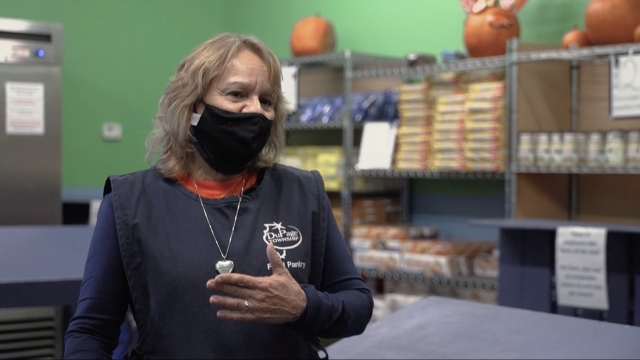Beneath her mask, Zully Frausto greets customers with a smile.
As a volunteer at the DuPage Township Food Pantry in suburban Chicago, she is known by regulars as "The Meat Lady."
"We have ham here, sausage sometimes, we've got chicken," she said.
But her ties to the pantry didn't start when she volunteered. It started with a personal experience five years ago. Frausto's husband left the workforce after undergoing hip replacement surgery.
"In that time, medical leave, you wait for money to come in. We had some different fallbacks of paperwork and nothing was coming in for months," she said. "I mean, we were just barely making it and just depleting and using what funds we could."
In a surprising and sobering moment, her family's need outweighed her pride.
"In my mind, you know, I kept mulling it over — 'Should I or shouldn't I.' So, finally, I let that pride get out of my head and I said, 'Hey, you know what? I've got to do something to feed our family.'"
She turned to the DuPage Township Pantry in Romeoville, Illinois, where she was told: "We got you with open arms. There's enough here to give you. Come on in."
Over 13 million U.S. households experienced limited or uncertain access to enough food in 2020, according to the USDA.
The experience can range from low food insecurity where the variety or quality of a diet changes — but food intake stays the same — to very low food insecurity, where eating habits are disrupted and less food is consumed.
Add up each person in those households and 15 million were children.
"We estimate that 60 million — six zero — million people accessed the charitable food system in this country," Feeding America president Katie Fitzgerald said.
When it comes to food insecurity, it's not just one type of person who will face it or deal with that challenge. It affects many different types of people, some in particular more than others. It can range from people of color to the elderly, to children, to folks with disabilities or people experiencing homelessness.
A full-time job doesn't guarantee secure access to food. Fifty percent of food-insecure households are employed full-time, according to the USDA.
Nearly 30% of food insecure households are led by a single woman with children. Regionally, the food insecurity rate is highest in the south.
"The stores are very expensive — the food — and my money is not enough," food pantry customer Ita Espinoza said.
And as Frausto says: "You just don't know ... when you're going to be in need. And we just never know. We just never know."
She shopped at the food pantry for six months and then her family got back on its feet. On her last day of shopping, she decided to pay it forward with the same warmth she received in her time of need.
"I just said to myself, you know, 'Now it's my turn to give,'" Frausto said.


